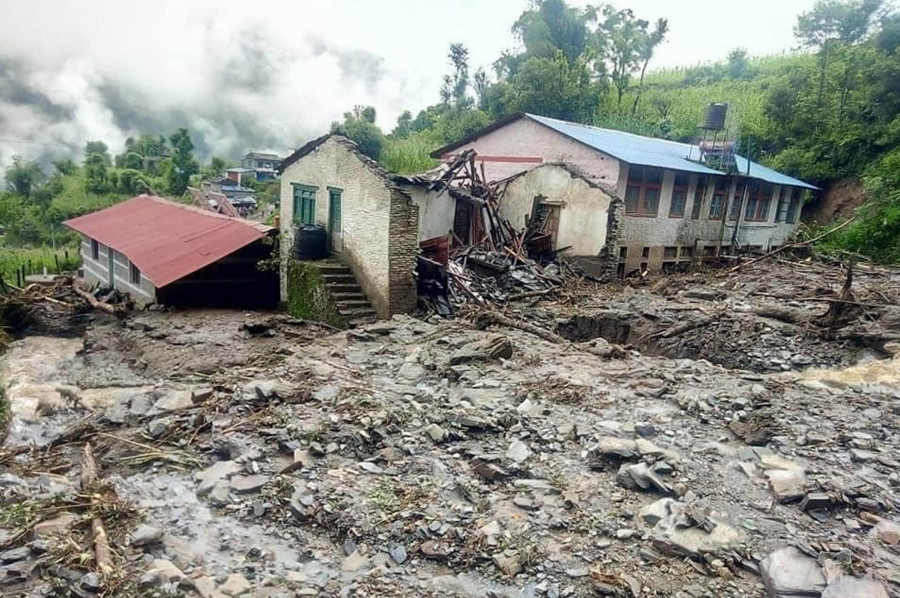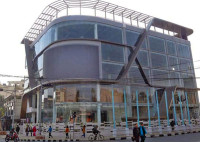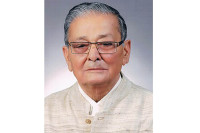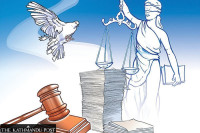National
When disasters strike, police are the first responders, but they are severely ill-equipped
Difficult geographic conditions make it even more difficult, necessitating more local involvement in rescue and relief operations, experts and officials say.
Shuvam Dhungana
On the night of July 9, when the phone rang at around 2:30am at Myagdi District Police Office, Inspector Dhruba Sharma knew that it was a call for rescue. It had been raining for the past few days. Someone from the other side said landslides had buried around four houses in Dhaulagiri Rural Municipality Ward 7, said Sharma.
“As soon as we received the information, we set off to the site,” said Sharma. “But it took us 24 hours to reach there.”
The roads were blocked by landslide debris and the police team lacked equipment to clear them.
“All we were carrying were basic tools like ropes, spades, hoes and sickle,” Sharma told the Post. “And only an excavator could clear the roads. At times, we can do nothing even after reaching the site.”
Police are the first responders during accidents and natural disasters in the country. But they are so ill-equipped that at times they cannot reach the incident site on time—like in Myagdi’s case.
“The Nepal Army and the Armed Police Force are mobilised in disaster response only when the police’s rescue and relief efforts prove to be insufficient,” said Gyannath Dhakal, chief district officer for Myagdi, who also heads the disaster management committee like other CDOs do in their districts.
Sharma and his team finally reached Dhaulagiri Rural Municipality Ward 7 on July 10. Police recovered 29 bodies on that day across the district.
The police were supported by the Nepal Army and the Armed Police personnel.
Every monsoon, different parts of the country witness dozens of floods and landslide incidents.
As per the Nepal Disaster Risk and Management Act-2017, local federal units undertake the task of disaster management.
“But we do not have trained manpower to execute rescue works and we have to turn to the district, provincial and federal governments who have the power to deploy security personnel to disaster sites,” said Sam Bahadur Grabuja, chairman of Annapurna Rural Municipality in Myagdi.
The police department does have specially trained personnel for disaster rescue in every province. “Over 1,000 personnel are specially trained for such rescue operations,” said Additional Inspector General Niraj Bahadur Shahi, for the Nepali Police.
But just the training is not enough; equipment is equally important, according to police personnel involved in rescue operations.
“Our security personnel must be applauded for the efforts they put in to save lives and recover bodies despite potential risks to their own lives,” said Anil Pokharel, chief operating officer of the National Disaster Risk Reduction and Management Authority, the federal body established in December 2019 as per the 2017 Act. The Authority replaces the Disaster and Conflict Management Division at the Ministry of Home Affairs which earlier oversaw all the disaster-related rescue and recovery efforts across the country.
“Remoteness is the main issue,” said Pokharel.“Even after knowing about the incident, we fail to reach the incident site in time due to geographic and weather conditions.”
Pokharel concedes that there is a shortage of equipment.
“We also need advanced equipment. For example, bodies may have been buried in debris but the exact location of the body cannot be ascertained without a scanning device,” said Pokhrel. “Imagine the pain of a family while it is waiting for a body to be recovered or if a body is never recovered.”
Compared to Nepal Police, the Army and the Armed Police Force have more trained personnel.
According to Brigadier General Santosh Ballav Poudel, spokesperson for the Nepal Army, the national defence force has around 5,000 personnel who are specially trained for all kinds of rescue operations. The Army is also better equipped than Nepal Police. It has lifeboats and its own firefighting engines.
Deputy Inspector General Prabin Kumar Shrestha, spokesperson for the Armed Police Force, said the APF has 3,000 trained personnel, including divers. The APF also has a Disaster Management Training Centre in Kathmandu which imparts training on relief and rescue operations to the personnel.
“Coordination among the security forces has never been an issue during the times of disaster,” said Pokharel. “When it comes to capacity building, we certainly fall behind.”
While response to disasters is key, the more important aspect is preparedness and risk minimisation, says experts and authorities.
“We need to focus more on preparedness than response,” said Madhukar Upadhya, a climate change adaptation expert. “For example, we need weather forecasts to be as precise as possible, we need to take the local knowledge of where landslides and floods are likely to happen and warn communities accordingly.”
According to Upadhya, risk information comes from historical knowledge of local conditions and high science.
“But local bodies do not have access to high science and this is where the federal and provincial governments need to step in,” said Upadhya. “Any disaster is first and foremost a local event and the locals are the first responders and the ones affected.”
Pokhrel said since local people have to respond to disasters before security forces arrive, they also need some basic training.
“Therefore our efforts in capacity building will focus on training volunteers who can work together with security forces,” said Pokharel. “We want to have about 50 trained volunteers at every ward across the country. This, however, will take time.”
For now, local people have to rely on the ill-equipped police to arrive whenever a disaster strikes.
“We need rain suits, boots and helmets for our safety and ladders and electric-powered cutters to cut through debris,” said Inspector Sharma. “However, we lack such equipment.”




 16.12°C Kathmandu
16.12°C Kathmandu














